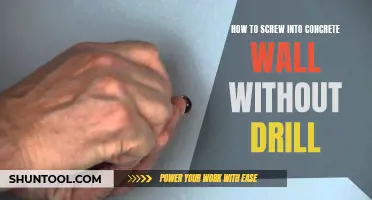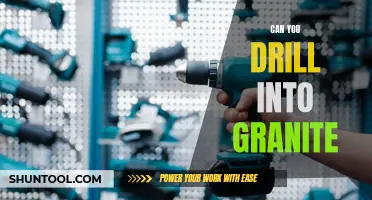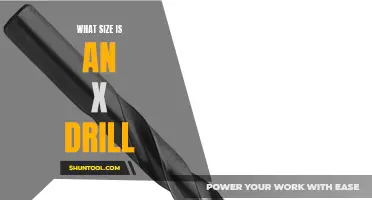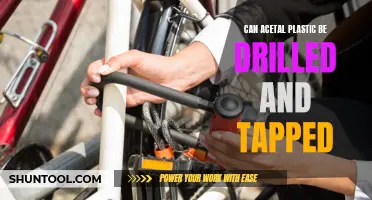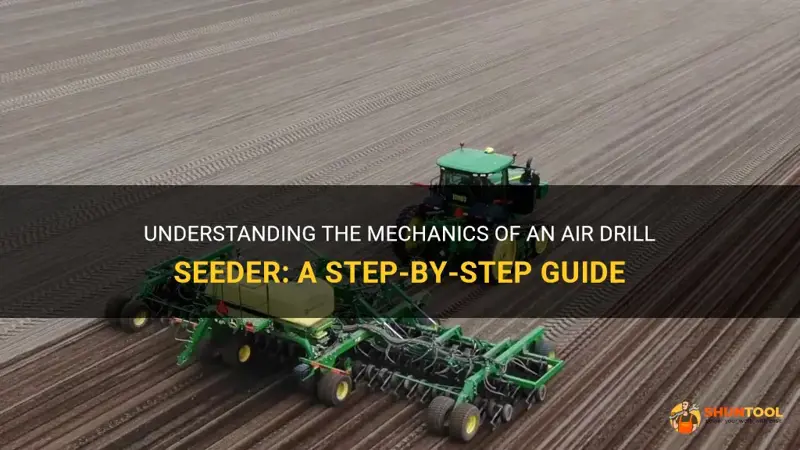
Imagine having to plant thousands of seeds manually. It would be a laborious and time-consuming task. Luckily, we have the brilliant invention of the air drill seeder, which revolutionizes the way we plant crops. This modern agricultural machine combines the power of compressed air and precision engineering to effortlessly sow seeds in the soil with great accuracy and efficiency. Join me as we delve into the inner workings of an air drill seeder and witness the seamless integration of technology and agriculture.
| Characteristics | Values |
|---|---|
| Type of seed | Variable, depending on crop type |
| Working width | Typically ranges from 20 ft to 40 ft |
| Seed depth | Adjustable, typically 1" to 3" |
| Seed spacing | Adjustable, typically 6" to 12" |
| Number of rows | Depends on model, can range from 15 to 40 |
| Seed metering system | Typically uses a combination of drills and flutes to meter and distribute seeds evenly |
| Seed distribution | Uses air pressure to move seeds from the hopper to the seed meters, which then drop the seeds into the furrows created by the drills |
| Fertilizer application | Some air drill seeders have the capability to apply fertilizer simultaneously with seed planting |
| Hitch type | Can be towed behind a tractor or mounted on a cultivator or toolbar |
| Ground engagement | Typically uses disc or hoe openers to create furrows for seed placement |
| Depth control | Can be adjusted hydraulically or manually |
| Downforce | Can be adjusted to ensure proper seed-to-soil contact |
| GPS and mapping capabilities | Some models offer GPS and mapping features for precise seed placement and record keeping |
What You'll Learn
- What is the purpose of an air drill seeder and how does it work?
- What are the main components of an air drill seeder?
- How does an air drill seeder distribute seeds and how does it ensure accurate spacing and depth?
- What factors can affect the performance of an air drill seeder and how can they be optimized for different soil and crop types?
- What are the advantages and disadvantages of using an air drill seeder compared to other seeding methods?

What is the purpose of an air drill seeder and how does it work?
An air drill seeder is a powerful agricultural machine that is used to plant seeds in a fast and efficient manner. It is commonly used in large-scale farming operations to cover a large area of land in a short period of time. The purpose of an air drill seeder is to simplify the planting process and ensure uniform seed spacing, which ultimately leads to higher crop yields.
So how does an air drill seeder work? Let's break it down step-by-step.
Step 1: Preparation - Before using the air drill seeder, the farmer must prepare the land by tilling and leveling the soil. This creates a smooth and even surface for planting the seeds.
Step 2: Loading the seed hopper - The air drill seeder has a large container called a seed hopper, where the seeds are stored. The farmer loads the hopper with the desired type and amount of seeds that will be planted.
Step 3: Metering and delivery - The seeds in the hopper are then metered using a mechanism that controls the flow rate. This ensures that a consistent amount of seeds is delivered to the distribution system.
Step 4: Air distribution - The air drill seeder uses air pressure to distribute the seeds evenly across the field. The seeds are mixed with a stream of air, which carries them through a series of tubes and hoses to the individual seed openers.
Step 5: Seed placement - The individual seed openers, also known as coulters, create small furrows in the soil where the seeds will be placed. As the machine moves forward, the coulters open the soil, and the seeds are dropped into the furrows.
Step 6: Soil covering - After the seeds are dropped, the coulters cover them with soil using specialized discs. This ensures that the seeds are properly protected and have good soil contact for germination.
Step 7: Packing - To further promote seed-to-soil contact, some air drill seeders have packing wheels or press wheels that gently compact the soil around the seeds. This helps prevent seed drying and aids in the early stages of germination.
Step 8: Repeating the process - The air drill seeder continues moving forward, repeating the process of seeding, covering, and packing until the entire field is planted.
One of the advantages of using an air drill seeder is its ability to plant seeds at precise depths and spacing. This results in better seed emergence and can ultimately lead to improved crop yields. Additionally, the use of air pressure allows for accurate seed distribution, minimizing waste and ensuring that the seeds are evenly spread across the field.
Another benefit of an air drill seeder is its efficiency in terms of time and labor. With its wide working width and high capacity, a single air drill seeder can cover a significant area of land in a short amount of time. This makes it particularly useful for farmers who need to plant large fields efficiently.
In conclusion, an air drill seeder is an essential tool in modern agriculture. It simplifies the process of planting seeds, ensures uniform seed spacing, and promotes better crop yields. By understanding how an air drill seeder works and its benefits, farmers can make informed decisions about incorporating this technology into their farming practices.
Choosing the Right Size Drill Bit for an M10 Anchor Bolt: A Guide
You may want to see also

What are the main components of an air drill seeder?
Air drill seeders are widely used in modern agriculture for effectively sowing seeds and improving crop yields. These machines are composed of several main components that work together to facilitate efficient and precise seeding.
- Seed Hopper: The seed hopper is a large container that holds the seeds to be sown. It is usually made of durable and weather-resistant material, such as plastic or metal, and is designed to prevent seed spillage during operation. The hopper may have a capacity ranging from a few hundred to several thousand pounds, depending on the size of the seeder.
- Distribution System: The distribution system of an air drill seeder is responsible for transporting the seeds from the hopper to the seeding mechanism. This system typically consists of a metering device or metering wheel that controls the flow of seeds, along with augers or conveyors that move the seeds towards the seeding mechanism.
- Seeding Mechanism: The seeding mechanism is the component that ensures the seeds are placed at the desired depth and spacing in the soil. Different types of seeding mechanisms may be used, depending on the specific requirements of the crop being seeded. Some common examples include disc openers, shank openers, or double disc openers, which create a furrow in the soil where the seeds are deposited.
- Press Wheels: Press wheels are used to ensure proper seed-to-soil contact after the seeds are sown. These wheels apply downward pressure on the soil surface, helping to achieve good seed germination and emergence. The width and design of the press wheels can be adjusted to accommodate different soil types and seeding conditions.
- Seed Tubes: Seed tubes connect the distribution system to the seeding mechanism, carrying the seeds from the hopper to the furrows created by the openers. They are designed to deliver the seeds accurately and evenly, preventing any blockages or inconsistencies in the seed placement. Seed tubes may be made of plastic or metal, depending on the seeder model.
- Fan and Air Distribution System: The fan and air distribution system are crucial components of an air drill seeder, as they provide the necessary airflow to transport the seeds from the hopper to the distribution system and then to the seeding mechanism. The air pressure generated by the fan helps to create a controlled seed flow and ensures accurate seed placement.
- Depth Control System: To achieve consistent seed depth, air drill seeders usually incorporate a depth control system. This system allows the operator to adjust the depth at which the seeds are sown based on the requirements of the crop and soil conditions. It typically consists of depth wheels or hydraulic cylinders that control the depth of the seeding mechanism.
In summary, an air drill seeder is composed of a seed hopper, distribution system, seeding mechanism, press wheels, seed tubes, fan and air distribution system, as well as a depth control system. These components work together to accurately and efficiently sow seeds, promoting optimal crop growth and yield. By using air drill seeders, farmers can effectively streamline the seeding process and maximize their agricultural productivity.
The Step-by-Step Guide to Successfully Drill a Screw into a Tiled Wall
You may want to see also

How does an air drill seeder distribute seeds and how does it ensure accurate spacing and depth?
An air drill seeder is a piece of agricultural equipment used for planting crops, such as grains or oilseeds, in large-scale farming operations. This innovative machinery has revolutionized the process of seeding by improving efficiency, accuracy, and overall crop yield. In this article, we will dive into the workings of an air drill seeder, focusing on how it distributes seeds and ensures accurate spacing and depth.
Firstly, let's understand how an air drill seeder operates. The seed distribution mechanism of this equipment relies on a combination of air pressure and mechanical systems. Once the seeds are loaded into a hopper, they are distributed through a series of tubes and hoses. These tubes are connected to a fan, which creates air pressure to push the seeds out of the distribution system and into the ground. The airflow generated by the fan not only ensures a steady seed flow but also helps in distributing them evenly across the field.
Accurate spacing and depth are crucial factors for successful crop growth. An air drill seeder tackles these challenges effectively. To achieve accurate spacing, the seeder utilizes a row unit system. Each row unit consists of a disc opener, a seed tube, and a press wheel. The disc opener creates a furrow, the seed tube delivers the seed into the furrow, and the press wheel compacts the soil over the seed. The distance between each row unit can be adjusted, allowing for precise spacing according to the crop requirements.
Moreover, an air drill seeder incorporates advanced technologies, such as electronic seed rate control and GPS guidance systems, to ensure precise seed placement. The electronic seed rate control enables the operator to adjust the amount of seed being distributed, resulting in consistent spacing and optimal seed density. The GPS guidance system ensures accurate positioning of the seeder, reducing overlap and preventing skips, thereby improving the overall efficiency and crop uniformity.
In addition to the mechanisms and technologies employed, the design of the seed tubes also plays a crucial role in achieving accurate depth. The seed tubes are designed with specific shapes and angles to ensure that the seeds are placed at the desired depth in the soil. The depth can be adjusted based on the crop requirements and soil conditions, allowing for optimal seed-to-soil contact and germination.
To illustrate the effectiveness of an air drill seeder, let's consider the example of wheat farming. Wheat requires precise seed placement to ensure uniform emergence and achieve maximum yields. By using an air drill seeder, farmers can achieve consistent spacing between the wheat rows, which helps in maximizing sunlight exposure and nutrient uptake by each plant. Furthermore, the accurate depth control of the seeder ensures that the seeds are placed at the ideal depth for proper root development and access to moisture.
In conclusion, an air drill seeder is a remarkable piece of agricultural equipment that enhances the seeding process through its seed distribution mechanism, precise spacing, and accurate depth control. By utilizing air pressure, advanced technologies, and well-designed seed tubes, this seeder ensures even seed distribution, improves efficiency, and ultimately contributes to higher crop yields. Whether it's planting grains, oilseeds, or any other crop, an air drill seeder proves to be an invaluable tool for modern-day farming operations.
Do I Really Need a Hammer Drill to Drill into Mortar?
You may want to see also

What factors can affect the performance of an air drill seeder and how can they be optimized for different soil and crop types?
Air drill seeders are widely used in modern agriculture for accurate and efficient seed placement. The proper functioning of an air drill seeder is crucial for achieving high crop yields. There are several factors that can affect the performance of an air drill seeder, including soil conditions, seed type, seeding rate, ground speed, and opener design. By optimizing these factors based on specific soil and crop types, farmers can maximize the effectiveness of their air drill seeders and ultimately increase their yield potential.
Soil conditions play a significant role in the performance of an air drill seeder. Factors such as soil type, moisture content, and compaction can impact the seed placement and seed-to-soil contact. Different soil types require different adjustments to achieve optimal performance. For example, in heavy clay soils, it is important to set the opener depth accurately to ensure proper seed placement and minimize sidewall smearing. On the other hand, in light sandy soils, adjusting the opener to a slightly deeper depth can help improve seed-to-soil contact and prevent seed drying.
The type of seed being planted also affects the performance of an air drill seeder. Different seed sizes and shapes require different adjustments to ensure accurate placement and uniform seed spacing. For instance, small seeds like canola or alfalfa may require a lower air pressure to avoid over-seeding, whereas larger seeds, such as corn or sunflower, may require higher air pressure for proper seed distribution.
The seeding rate is another crucial factor that directly affects crop establishment and yield potential. Farmers need to calibrate their air drill seeders accurately to achieve the desired seeding rate. Over-seeding can lead to competition among plants and reduce crop yield, while under-seeding can result in poor plant stand and reduced crop vigor. Regularly monitoring the seeding rate during the seeding operation and making necessary adjustments based on seed germination and emergence can significantly improve the performance of an air drill seeder.
The ground speed at which the air drill seeder operates can also impact its performance. Operating the seeder at higher ground speeds can result in increased seed bounce and uneven seed placement. Slower ground speeds are generally recommended to ensure accurate seed placement and optimal seed-to-soil contact. However, it is essential to strike a balance between ground speed and work efficiency, as excessively slow operation can reduce overall productivity.
Opener design is another critical factor that affects the performance of an air drill seeder. Different opener designs are available, such as single disc, double disc, or hoe opener. The choice of opener design depends on the specific soil and crop conditions. For instance, a double disc opener works better in heavy residue conditions, while a single disc opener is more effective in light residue or no-till conditions. Selecting the appropriate opener design based on soil and crop conditions can optimize the performance of an air drill seeder.
In conclusion, optimizing the performance of an air drill seeder requires careful consideration of various factors, including soil conditions, seed type, seeding rate, ground speed, and opener design. By adjusting these factors based on specific soil and crop types, farmers can ensure accurate seed placement, good seed-to-soil contact, and ultimately improve crop establishment and yield potential. Regular monitoring and calibration of the air drill seeder during the seeding operation are also essential to maintain optimal performance and maximize productivity.
Is Drilling Considered Hot Work? Exploring the Potential Hazards of Drilling Processes
You may want to see also

What are the advantages and disadvantages of using an air drill seeder compared to other seeding methods?
Air drill seeders are a popular choice among farmers and gardeners when it comes to seeding their fields or gardens. This method of seeding offers several advantages over other traditional seeding methods, such as broadcasting or hand seeding. However, there are also some disadvantages associated with air drill seeders that users should be aware of. In this article, we will explore the advantages and disadvantages of using an air drill seeder compared to other seeding methods.
Advantages of Air Drill Seeders:
- Even distribution of seeds: One of the main advantages of using an air drill seeder is that it allows for even distribution of seeds. The seeder disperses the seeds uniformly across the field or garden, ensuring that each plant gets the same amount of seeds. This results in better plant spacing and leads to more consistent and uniform plant growth.
- Time-saving: Air drill seeders are designed to cover a large area in a relatively shorter amount of time. Compared to broadcasting or hand seeding, where each seed is planted individually, air drill seeders can plant multiple seeds at once, speeding up the seeding process significantly. This time-saving feature is particularly useful for farmers who have large fields to cover.
- Precision planting: Air drill seeders offer precision planting capabilities, allowing users to control the depth and spacing of the seeds. This precision planting ensures that each seed is planted at the optimal depth for germination and growth. Additionally, the controlled spacing of seeds helps prevent overcrowding and competition among plants, resulting in higher crop yield.
- Reduced seed wastage: Unlike broadcasting methods, which often result in seeds being scattered beyond the targeted area, air drill seeders are designed to deliver seeds directly to the soil. This reduces seed wastage and ensures that a higher percentage of seeds actually germinate and grow into healthy plants.
Disadvantages of Air Drill Seeders:
- Initial cost: One of the main disadvantages of air drill seeders is their initial cost. Air drill seeders are generally more expensive compared to other traditional seeding methods. The machinery and equipment required for air drill seeding can be a significant investment for small-scale farmers or gardeners.
- Maintenance and repairs: Air drill seeders require regular maintenance and occasional repairs to ensure their optimal performance. The machinery and equipment in air drill seeders can be complex, and any malfunctions or breakdowns can result in downtime and additional costs.
- Limited suitability for certain soil types: Air drill seeders may not be suitable for all soil types. Heavy clay or compacted soils can pose challenges for air drill seeders, as they may struggle to penetrate the soil or may result in uneven seed placement. In such cases, other seeding methods such as broadcasting or hand seeding may be more effective.
- Dependency on weather conditions: Air drill seeders are generally more dependent on favorable weather conditions for optimal seeding. Wind can affect the even distribution of seeds, causing them to drift off-target. Rain immediately after seeding can also wash away the seeds, resulting in poor germination. In contrast, broadcasting or hand seeding can be done more flexibly depending on weather conditions.
In conclusion, air drill seeders offer several advantages over other seeding methods, such as even distribution of seeds, time-saving, precision planting, and reduced seed wastage. However, they also have their disadvantages, including the initial cost, maintenance and repairs, limited suitability for certain soil types, and dependency on weather conditions. When choosing a seeding method, it's important to consider the specific needs of the field or garden as well as the resources available.
The Earnings of BP: An In-Depth Look into Drilling Revenue
You may want to see also
Frequently asked questions
An air drill seeder is a type of seeding machine that uses compressed air to distribute seeds into the soil.
The key components of an air drill seeder include a seed hopper, an air delivery system, seed meters, and a distribution system.
The seed hopper is where the seeds are stored. They are then released into the air delivery system, which uses compressed air to create a vacuum and pull the seeds towards the seed meters.
The distribution system consists of tubes and distribution boots that evenly distribute the seeds into the soil. The distribution boots are placed at the bottom of the furrows created by the drill, ensuring accurate seed placement.


